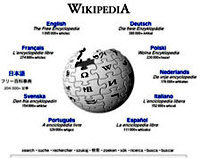BROWSE BY CATEGORY
- Archives and Libraries
- Blogs and Networking
- Bookmark This
- Digital Tools
- Examples of Teaching
- Exhibits
- Film Reviews
- History and Headlines
- Historic Sites and Museums
- Historical Thinking
- Holidays and Heritage
- Issues and Research
- Lesson Plans
- Material and Visual Culture
- Multimedia
- Organizations and Agencies
- Primary Sources
- Professional Development
- Publications
- Student Activities
- Teaching Materials
- Websites
Bookmark This! Beneath the Surface of Wikipedia

Wikipedia, the online, open-source encyclopedia, is no longer a new kid on the research web, but questions about its merits and use in the classroom continue to recycle.
Wikipedia is perhaps the most extensive example of democratic scholarship on the web. Tens of thousands of volunteer contributors have collectively written, revised, and edited nearly 3 million encyclopedia entries in English and other languages. Almost any Google search on topics relevant to teaching and learning history (among other subjects) elicits a Wikipedia entry among the top five search results—and frequently it occupies the number-one slot.
Students regularly and unquestioningly rely on Wikipedia as a resource for assignments. How, then, should educators respond to its ubiquity and accessibility? Many teachers simply banish it from the classroom. Banished or not, the encyclopedia is unlikely to disappear, and students will continue to be among the millions of inquiring minds who use it daily as a first stop for information-gathering. Teaching students how to evaluate Wikipedia may be a better solution, then, than ignoring its influence.
In fact, a hard look at the value and limitations of Wikipedia offers practical experience to students in critical thinking and analysis of primary and secondary sources in any subject area.
Start with this video from North Carolina State University Libraries: Wikipedia: Beneath the Surface (in under 6 minutes). The video gives an overview of Wikipedia and how it works—pros and cons—and situates its use as a tool promoting critical thinking.
In Can History be Open Source? Wikipedia and the Future of the Past, author Roy Rosenzweig, founder of George Mason University's Center for History and New Media, answers "some basic questions about history on Wikipedia. How did it develop? How does it work? How good is the historical writing? What are the potential implications for our practice as scholars, teachers, and purveyors of the past to the general public?" (This article was originally published in The Journal of American History Volume 93, Number 1 [June, 2006]: 117-46)
Carleton College Gould Library offers a faculty guide, Using Wikipedia. The article offers guidelines for using Wikipedia, suggestions about its role in the curriculum, and links to further analytical articles. Guidelines include a caution from Wikipedia founder, Jimmy Wales, that the encyclopedia is not a definitive source. "It's pretty good, but you have to be careful with it." He advises students to use Wikipedia for an overview of a topic, but then, to hit the history books.
Jeremy Boggs, digital historian and creative lead at the Center for History and New Media, authored a detailed lesson plan for undergraduate history classes, Assigning Wikipedia in a US History Survey. Boggs describes the assignment and the process of implementation, but also explains the rationale and benefits of this curriculum module, which he considers one of his most successful assignments. "Most of my students have a difficult time understanding how to make an argument, how to differentiate between fact-based 'reporting' and analysis. By actually being forced to write a 'just the facts' report, they have been able to see the difference between the two." The module is adaptable to high school coursework.